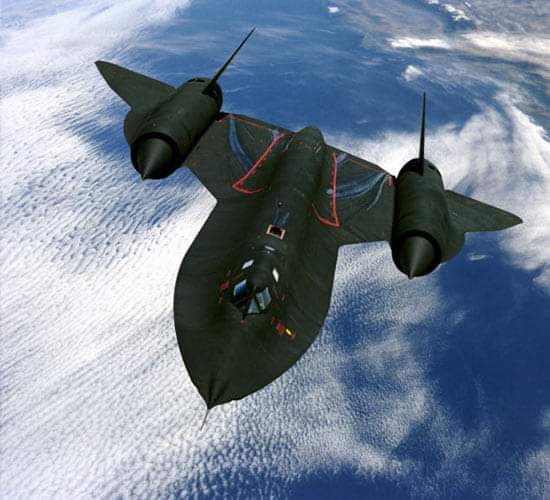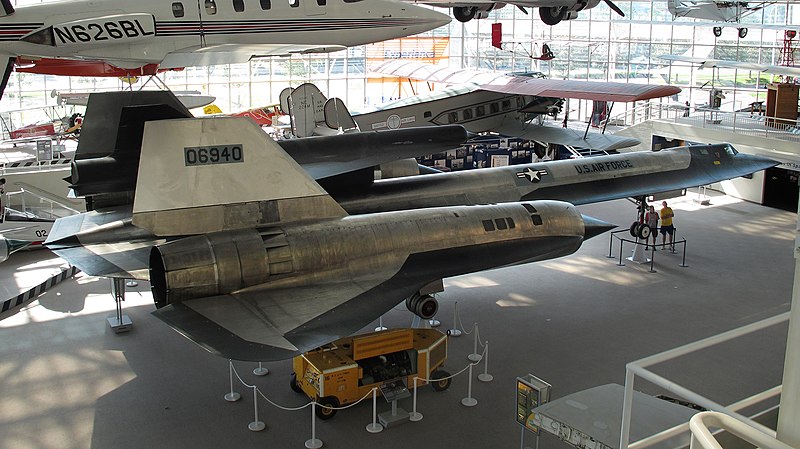WARFARE: 14 Awesome Facts About Lockheed SR-71 Blackbird, The World's Fastest Jet

Did you know that the SR-71 continues to hold the official world record it set in 1976 for the fastest air-breathing manned aircraft in the world, previously held by the related Lockheed YF-12?
The Lockheed SR-71 "Blackbird" is a long-range, high-altitude, Mach 3+ strategic reconnaissance aircraft developed and manufactured by the American aerospace company Lockheed Corporation, and was operated by both the United States Air Force (USAF) and the National Aeronautics and Space Administration (NASA).
The SR-71 Blackbird first flew in 1964 and was retired by NASA in 1999. Designed ahead of its time, the Blackbird gave the U..S. a powerful upper-hand during the Cold War as it was literally faster than a bullet.
The SR-71 was developed as a black project from the Lockheed A-12 reconnaissance aircraft during the 1960s by Lockheed's Skunk Works division. American aerospace engineer Clarence "Kelly" Johnson was responsible for many of the aircraft's innovative concepts. The shape of the SR-71 was based on that of the A-12, which was one of the first aircraft to be designed with a reduced radar cross-section.
At one point, a bomber variant of the aircraft was under consideration, before the program was focused solely on reconnaissance. Mission equipment for the reconnaissance role included signals intelligence sensors, a side-looking airborne radar, and a photo camera; the SR-71 was both longer and heavier than the A-12, allowing it to hold more fuel as well as a two-seat cockpit.
The SR-71 designation has been attributed to lobbying efforts by USAF Chief of Staff General Curtis LeMay, who preferred the SR (Strategic Reconnaissance) designation over simply RS (Reconnaissance, Strategic). The aircraft was introduced to operational service in January 1966.
During aerial reconnaissance missions, the SR-71 operated at high speeds and altitudes (Mach 3.2 and 85,000 feet, 25,900 meters) to allow it to outrace threats. If a surface-to-air missile launch was detected, the standard evasive action was simply to accelerate and outfly the missile. On average, each SR-71 could fly once per week due to the extended turnaround required after mission recovery. A total of 32 aircraft were built; 12 were lost in accidents with none lost to enemy action.
During 1988, the USAF retired the SR-71 largely for political reasons; several were briefly reactivated during the 1990s before their second retirement in 1998. NASA was the final operator of the type, retiring their examples in 1999. Since its retirement, the SR-71's role has been taken up by a combination of reconnaissance satellites and unmanned aerial vehicles (UAVs); a proposed UAV successor, the SR-72 is under development by Lockheed Martin, and scheduled to fly in 2025. The SR-71 has been given several nicknames, including "Blackbird" and "Habu".

Here are some awesome facts about the SR-71 Blackbird:
1) At a full velocity of Mach 3.3, the Blackbird's surface heated up to temperatures of 500+ degrees Fahrenheit.
2) No materials were available at the time to build such heat-resistant fuel cells. Instead, they were designed to allow for leakage and would subsequently expand with the heating of the aircraft, sealing the cracks.
3) Due to this critical fuel loss, the airplane had to be refueled immediately after takeoff, before it could continue with its mission.
4) The Blackbird was constructed mostly out of titanium alloy, with remaining parts constructed out of high-end composite materials.
5) The C.I.A. created several coverup companies which were used to purchase the required titanium for the construction of Blackbirds from Soviet Union.
6) Pilots were required to wear pressurized flight suits to cope with the low atmospheric pressure and lack of oxygen at high altitudes.
7) There's no glass panel here. The SR-71's cockpit was all-analog.
8) A 747 rotates at about 155 knots during takeoff. The SR-71 rotates at a very fast 210 knots.
9) The aircraft used parachutes in combination with wheel brakes to slow itself down.
10) Following landings, there were "cool-off" periods, when the ground crew and pilots were required to wait for the surfaces of the air frame to cool off.
11) A total of 3,551 mission sorties were flown to spy on military installations, troop movements and nuclear silos during the cold war with Soviet Union.
12) The SR-71's spy equipment allowed it to survey 100,000 square miles per hour of the Earth's surface from an altitude of 80,000+ feet.
13) It could operate safely at a maximum speed of Mach 3.3 at an altitude more than 16 miles, or 85,000 ft, above the Earth. At top speed, it would pass the bullet fired out of an M1 Garand Rifle by over 400 feet per second.
14) On March 6, 1990, Lt. Col. Ed Yeilding and Lt. Col. Joseph Vida flew a Blackbird from Los Angeles to Washington, D.C. in 1 hour, 4 minutes, and 20 seconds, setting a world speed record. Averaging 2,124 miles per hour, that record holds today.
SOURCES: Wikipedia & 14 Awesome Facts About the SR-71 Blackbird By Swayne Martin | bold method
#penglobalfactfile


_1755775186.jpg)
